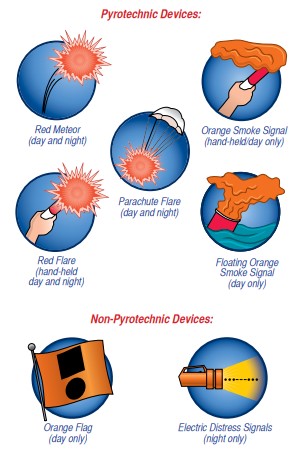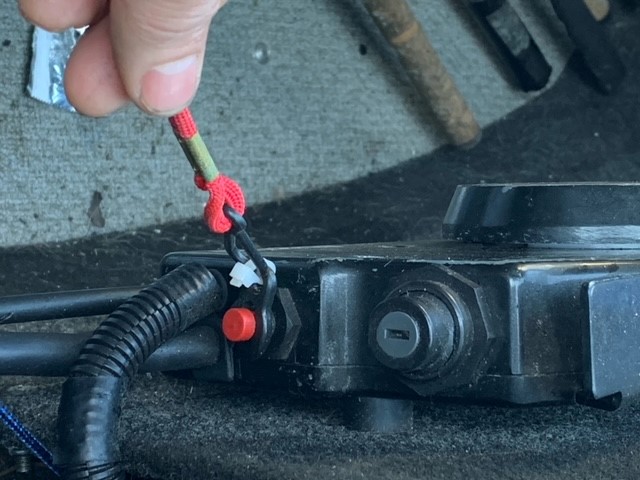Equipment for Type & Length of Boat
1. Wearable Life Jacket
Sailboats less than 16 feet in length and all paddlecraft (canoes, kayaks, stand up paddleboards, etc.) need to carry properly-fitting, U.S. Coast Guard -approved wearable life jacket(s) for each person on board and the life jacket must be readily accessible. All children 12 and younger are required to wear a life jacket.
Sailboats 16 feet and over must also carry one, Type IV throwable cushion.
2. Sound Devices
A boat less than 39 feet 4 inches (or 12 meters) long, must carry a whistle or a compressed air horn. It's easy to attach a whistle to a life jacket! Both are required equipment.
3. Navigation Lights
Required only when underway or at anchor between sunset and sunrise, and during periods of restricted visibility.
4. Waterway Access Permit (boats 10' and longer, including sail between 10'-11'9")
A waterway access permit is required on boats 10' long and longer, and sailboats between 10' and 11'. One permit per boat. Permits are transferrable to other non-motorized boats and children 13 and younger are exempt.
1. Wearable Life Jackets
Boats under 26 feet need to carry properly-fitting, U.S. Coast Guard -approved wearable life jacket(s) for each person on board and the life jacket must be readily accessible. The boat must also carry a Type IV throwable cushion. All children 12 and younger are required to wear a life jacket while on an open deck or cockpit when a boat is underway or being towed.
*Motorboats less than 16 feet in length and all paddlecraft need to carry properly-fitting, U.S. Coast Guard-approved life jacket(s) for each person on board and the life jacket must be readily accessible, but are not required to carry a Type IV throwable cushion.
A boat less than 39 feet 4 inches (12 meters) must carry a sound producing device such as a whistle or compressed air horn. It's easy to attach a whistle to a life jacket. Both are required equipment.
3. Fire Extinguisher when no fixed fire extinguishing system is installed. Every motorboat, except outboard motorboats less than 26 feet in length of open construction, shall carry on board, fully charged and in serviceable condition a B-I (or 5-B) type hand portable, marine-approved fire extinguisher.
The particular type depends on when the boat was built.
7. Navigation Lighting -Lights are required only when the boat is underway or at anchor between sunset and sunrise and during restricted visibility.
Part of your motorboat registration fees go into the Aquatic Invasive Species Prevention Program and Abandoned/Derelict Vessel Removal Fund, as well as helping fund marine law enforcement and boating facility grants.
1. Wearable Life Jacket
Boats 26 feet to 40 feet need to carry properly-fitting, U.S. Coast Guard -approved wearable life jacket(s) for each person on board and the life jacket must be readily accessible. The boat must also carry a Type IV throwable cushion that is readily accessible. All children 12 and younger are required to wear a life jacket at all times while on anopen deck or cockpit when a boat is underway or being towed.
A boat less than 39 feet 4 inches (12 meters) must carry a sound producing device such as a whistle or compressed air horn. Both are even better for larger boats. Many larger boats have built-in horns.
3. Two, B-1 (or newer rating 5-B) Fire Extinguishers or one B-II (20-B) rated portable fired extinguisher. When an approved fixed fire extinguishing system is installed, one less B-I type is required.
The particular type dependent upon when the boat was built.
7. Navigation Lighting -Lights are required only when the boat is underway or at anchor between sunset and surise and during restricted visibility.
Part of your motorboat registration fees go into the Aquatic Invasive Species Prevention Program and Abandoned/Derelict Vessel Removal Fund, as well as helping fund marine law enforcement and boating facility grants.
1. Wearable Life Jackets Boats 40 feet and under 65 feet need to carry properly-fitting, U.S. Coast Guard -approved wearable life jacket(s) for each person on board and the life jacket must be readily accessible. The boat must also carry a Type IV throwable cushion that is readily accessible. All children 12 and younger are required to wear a life jacket at all times while on an open deck orr cockpit when a boat is underway or being towed.
2. Sound Devices
A boat of more than 39 feet 4 inches (12 meters), but less than 65 feet 6 inches (20 meters) must carry on board a bell and a whistle, or a horn. The whistle and the bell must comply with existing federal specifications.
3. Three, B-1 (or newer rating 5-B) fire extinguishers or one B-I (or 5-B) type plus one B-II (or newer rating 20-B) type approved portable fire extinguishers. When an approved fixed fire extinguishing system is installed, one less B-I (5-B) type is required.
4. Carburetor backfire flame arrestor is required for inboard motors not exposed to the atmosphere above the gunwale.
5. Muffling system for the exhaust of each internal combustion engine.
6. Ventilation System
The particular type dependent upon when the boat was built.
7. Navigation Lighting-Lights are required only when the boat is underway or at anchor between sunset and surise and during restricted visibility.
Part of your motorboat registration fees go into the Aquatic Invasive Species Prevention Program and Abandoned/Derelict Vessel Removal Fund, as well as helping fund marine law enforcement and boating facility grants.
Visual Distress Signals (VDS)
All boats operating in the ocean or coastal waters west of the line of demarcation (jetty tips) must carry U.S. Coast Guard-approved VDS.
VDS allows boat operators to signal for help in the event of an emergency.
There are three categories of visual distress signals:
1. Day signals (visible in bright sunlight)
2. Night signals (visible at night)
3. Both day and night signals
VDS are either pyrotechnic (smoke and flames) or non-pyrotechnic (non-combustible and electronic). Operators must select the appropriate devices and have the minimum quantity as referenced in 33CFR175.110 depending on which category. VDS must be U.S. Coast Guard-approved, in serviceable condition, and readily accessible.
If pyrotechnic devices are selected, a minimum of three must be carried. Any combination can be carried as long as they add up to three signals for day use and three signals for night use. Three day/night signaling devices meet both requirements. There's a variety and different combinations of pyrotechnic devices that can be onboard to meet the carriage requirements.
The most common U.S. Coast Guard-approved non-pyrotechnic devices are an Orange Day Flag (day) and Electronic Distress Signal (night) to meet requirements.
Engine Cut-Off Switches
In Oregon, OAR 250-010-0166 requires the use of engine cut-off switches while operating a motorboat at a planing speed. The rule does not apply if:
1. The boat is not equipped with an engine cut-off switch, or
2. The main helm of the boat is installed within an enclosed cabin.